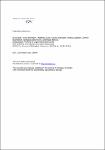Isotopologue Profiling of Legionella pneumophila
Role of Serine and Glucose as Carbon Substrates
Eylert, Eva
Herrmann, Vroni
Jules, Matthieu
Gillmaier, Nadine
Lautner, Monika
Buchrieser, Carmen
Eisenreich, Wolfgang
Heuner, Klaus
Legionella pneumophila (Lp) is commonly found in freshwater habitats but is also the causative agent of Legionnaires' disease when infecting humans. Although various virulence factors have been reported, little is known about the nutrition and the metabolism of the bacterium. Here, we report the application of isotopologue profiling for analyzing the metabolism of L. pneumophila. Cultures of Lp were supplied with [U-(13)C(3)]serine, [U-(13)C(6)]glucose, or [1,2-(13)C(2)]glucose. After growth, (13)C enrichments and isotopologue patterns of protein-derived amino acids and poly-3-hydroxybutyrate were determined by mass spectrometry and/or NMR spectroscopy. The labeling patterns detected in the experiment with [U-(13)C(3)]serine showed major carbon flux from serine to pyruvate and from pyruvate to acetyl-CoA, which serves as a precursor of poly-3-hydroxybutyrate or as a substrate of a complete citrate cycle with Si specificity of the citrate synthase. Minor carbon flux was observed between pyruvate and oxaloacetate/malate by carboxylation and decarboxylation, respectively. The apparent lack of label in Val, Ile, Leu, Pro, Phe, Met, Arg, and Tyr confirmed that L. pneumophila is auxotrophic for these amino acids. Experiments with [(13)C]glucose showed that the carbohydrate is also used as a substrate to feed the central metabolism. The specific labeling patterns due to [1,2-(13)C(2)]glucose identified the Entner-Doudoroff pathway as the predominant route for glucose utilization. In line with these observations, a mutant lacking glucose-6-phosphate dehydrogenase (Delta zwf) did not incorporate label from glucose at significant levels and was slowly outcompeted by the wild type strain in successive rounds of infection in Acanthamoeba castellanii, indicating the importance of this enzyme and of carbohydrate usage in general for the life cycle of Lp.
No license information
Related Items
Show related Items with similar Title, Author, Creator or Subject.
-
2013-03-11ZeitschriftenartikelTowards further reduction and replacement of animal bioassays in prion research by cell and protein misfolding cyclic amplification assays Boerner, Susann; Wagenführ, Katja; Daus, Martin L.; Thomzig, Achim; Beekes, MichaelLaboratory animals have long since been used extensively in bioassays for prions in order to quantify, usually in terms of median infective doses [ID50], how infectious these pathogens are in vivo. The identification of ...
-
2011-09-01ZeitschriftenartikelInfluenza Virus Ribonucleoprotein Complexes Gain Preferential Access to Cellular Export Machinery through Chromatin Targeting Chase, Geoffrey P.; Rameix-Welti, Marie-Anne; Zvirbliene, Aurelija; Zvirblis, Gintautas; Götz, Veronika; Wolff, Thorsten; Naffakh, Nadia; Schwemmle, MartinIn contrast to most RNA viruses, influenza viruses replicate their genome in the nucleus of infected cells. As a result, newly-synthesized vRNA genomes, in the form of viral ribonucleoprotein complexes (vRNPs), must be ...
-
2010-07-08ZeitschriftenartikelLegionella pneumophila induces human beta Defensin-3 in pulmonary cells Scharf, Stefanie; Vardarova, Kremena; Lang, Friederike; Schmeck, Bernd; Opitz, Bastian; Flieger, Antje; Heuner, Klaus; Hippenstiel, Stefan; Suttorp, Norbert; N'Guessan, Philippe DBackground: Legionella pneumophila is an important causative agent of severe pneumonia in humans. Human alveolar epithelium and macrophages are effective barriers for inhaled microorganisms and actively participate in the ...

